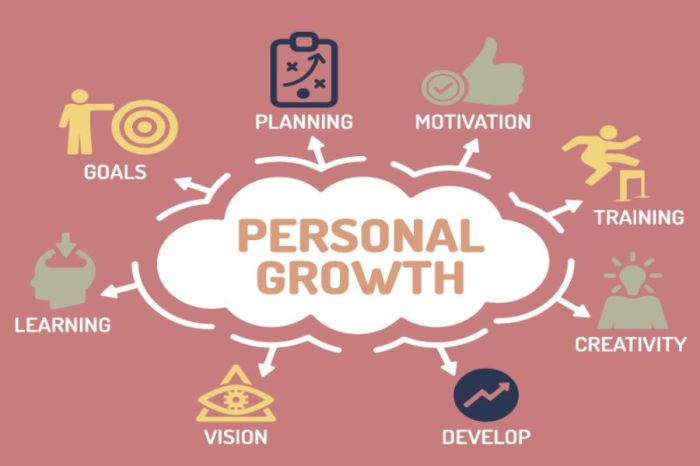Personal growth strategies are like the secret sauce to unlocking your full potential and living your best life. Imagine a world where every decision you make leads to growth and fulfillment. That’s the power of personal growth strategies.
From setting achievable goals to overcoming obstacles, this guide will take you on a journey of self-discovery and empowerment, showing you how to design a life you love.
Importance of Personal Growth Strategies
Personal growth strategies play a crucial role in shaping our lives and overall well-being. By investing in our personal growth, we can unlock our full potential, achieve our goals, and lead a more fulfilling life.
Positive Impact on Various Aspects of Life
Implementing personal growth strategies can positively impact various aspects of life. For instance, setting and achieving personal goals can boost self-confidence and motivation. Developing new skills and knowledge can enhance career prospects and financial stability. Improving communication and relationships can lead to better social connections and emotional well-being.
Essential for Overall Well-being
Personal growth strategies are essential for overall well-being as they help us evolve and adapt to life’s challenges. By continuously learning, growing, and improving ourselves, we can become more resilient, flexible, and better equipped to handle obstacles and setbacks. Embracing personal growth also fosters a sense of purpose, direction, and self-awareness, leading to a more meaningful and satisfying life.
Increased Happiness and Fulfillment
When we prioritize personal growth and invest in ourselves, we are more likely to experience increased happiness and fulfillment. By pursuing our passions, honing our strengths, and working towards self-improvement, we can cultivate a sense of accomplishment, satisfaction, and joy in our lives. Personal growth strategies empower us to create the life we desire, filled with purpose, positivity, and fulfillment.
Types of Personal Growth Strategies
Personal growth strategies come in various forms, each serving a distinct purpose in helping individuals develop and improve themselves. Here are some common types of personal growth strategies:
Goal Setting, Personal growth strategies
Goal setting is a powerful strategy that involves defining specific objectives and creating a plan to achieve them. By setting clear and achievable goals, individuals can stay focused, motivated, and track their progress effectively.
Self-Reflection
Self-reflection is a key strategy that involves introspection and evaluation of one’s thoughts, feelings, and actions. Through self-reflection, individuals can gain insights into their strengths, weaknesses, values, and beliefs, leading to personal growth and self-awareness.
Skill Development
Skill development is another essential strategy that focuses on acquiring new skills or improving existing ones. By continuously learning and honing skills, individuals can enhance their capabilities, adapt to new challenges, and increase their personal and professional growth.
Short-term vs Long-term Personal Growth Strategies

Short-term personal growth strategies typically involve immediate actions or changes that can lead to quick improvements or results. On the other hand, long-term personal growth strategies require sustained effort and commitment over an extended period to achieve significant and lasting transformations.
Short-term Personal Growth Strategies
– Engaging in daily affirmations to boost self-confidence.
– Attending workshops or seminars to enhance specific skills.
– Setting short-term goals to create momentum and motivation.
Long-term Personal Growth Strategies
– Pursuing higher education or advanced certifications.
– Developing a consistent exercise routine for physical and mental well-being.
– Building strong relationships and networks for personal and professional growth.
Personal Experiences with Personal Growth Strategies
Implementing personal growth strategies has been a transformative journey for me. By setting clear goals, practicing self-reflection, and continuously developing my skills, I have been able to overcome challenges, improve my confidence, and achieve personal milestones. Through consistent effort and dedication, I have witnessed positive outcomes in various aspects of my life, leading to continuous growth and self-improvement.
Developing a Personal Growth Plan

Creating a personalized plan for personal growth is essential for achieving your goals and becoming the best version of yourself. Here are the steps involved in developing a personal growth plan:
Setting Realistic Goals and Milestones
When creating your personal growth plan, it’s crucial to set realistic goals that are attainable and measurable. Here are some tips for setting goals and milestones:
- Start by identifying areas of improvement: Take some time to reflect on your strengths and weaknesses, and think about what areas of your life you want to focus on for personal growth.
- Set specific and measurable goals: Instead of setting vague goals like “be more successful,” set specific, measurable goals like “increase my income by 20% in the next year.”
- Break down your goals into smaller milestones: Achieving small wins along the way can help keep you motivated and on track towards your larger goals.
- Be flexible and adjust your goals as needed: It’s important to adapt your goals and milestones as circumstances change or as you learn more about yourself and what you want to achieve.
Adapting and Revising Your Personal Growth Plan
Adapting and revising your personal growth plan is a key component of the growth process. Here are some reasons why it’s important to be flexible with your plan:
- Life is unpredictable: Circumstances can change unexpectedly, so it’s important to be able to adjust your goals and strategies accordingly.
- Personal growth is an ongoing journey: As you grow and evolve as a person, your priorities and aspirations may shift, requiring you to revise your plan to reflect these changes.
- Learning from setbacks: Setbacks and failures are a natural part of the growth process. By adapting your plan in response to setbacks, you can turn these challenges into opportunities for learning and growth.
Overcoming Challenges in Personal Growth
When embarking on a journey of personal growth, individuals often encounter various obstacles that can hinder their progress. These challenges can range from self-doubt and fear to external factors such as lack of support or resources. Overcoming these hurdles is crucial in order to achieve personal growth and development.
Strategies for Overcoming Self-Doubt and Fear
- Acknowledge and challenge negative thoughts: Recognize when self-doubt or fear creeps in and actively challenge those thoughts by replacing them with positive affirmations.
- Seek support from others: Surround yourself with a supportive network of friends, family, or mentors who can provide encouragement and guidance during times of doubt.
- Step out of your comfort zone: Growth often occurs outside of our comfort zones, so push yourself to try new things and face your fears head-on.
- Practice self-care: Taking care of your physical, emotional, and mental well-being can help build resilience and confidence in overcoming self-doubt and fear.
The Role of Perseverance and Resilience in Achieving Personal Growth Goals
- Stay focused on your goals: Set clear objectives for your personal growth journey and stay committed to achieving them, even in the face of setbacks.
- Learn from failures: Embrace failures as learning opportunities and use them to fuel your determination to keep moving forward.
- Cultivate a growth mindset: Adopt a mindset that views challenges as opportunities for growth and development, rather than obstacles that hold you back.
- Practice gratitude: Reflect on your progress and accomplishments, no matter how small, to cultivate a positive outlook and build resilience in the face of challenges.